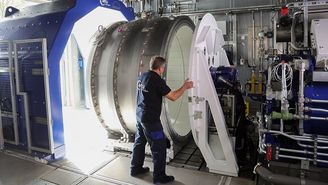
Effective heat treatment
Effective heat treatment
We use various heat treatment processes to ensure that components have a uniform microstructure and the requisite hardness. MTU Aero Solutions offers you access to these processes.
Annealing processes To achieve a uniform microstructure and proper hardness, normalizing, soft annealing, recrystallizing and stress relieving are used.
| Process | Objective | Operating Temperature °C |
|---|---|---|
| Normalizing |
| 900 – 960°C |
| Soft annealing |
| 700 – 900°C |
| Recrystallization annealing |
| 900 –1100°C |
| Stress-relief annealing |
| 400 –1180°C |
| Solution annealing |
| 600 –1180°C |
| Aging |
| 400 – 900°C |
These processes can be carried out in air, protective gas and vacuums (protective gas up to 950°C).
Hardening processes To prolong the life of components, they are hardened and tempered.
| Process | Objective | Operating temperature °C |
|---|---|---|
| Precipitation hardening |
| 400 –1190°C |
| Quenching and tempering |
| 500 – 940°C 700 –1050°C |
| Case hardening |
| 800 – 940°C |
| Carburizing |
| 900 – 930 °C |
| Gas nitriding |
| 490 – 525°C |
| Hardness testing | All common hardness testing methods |





